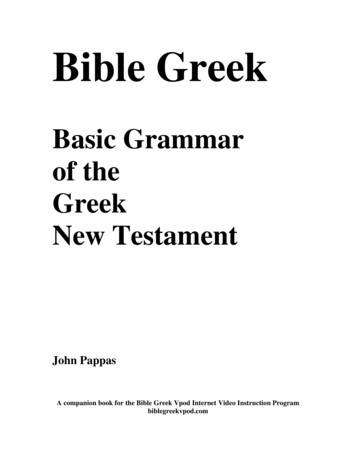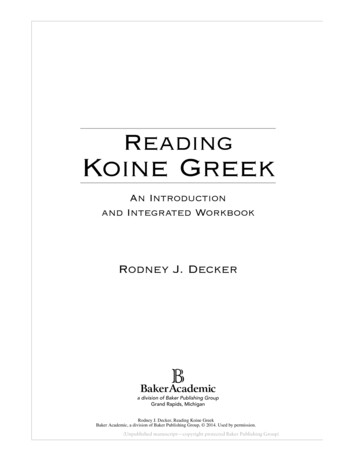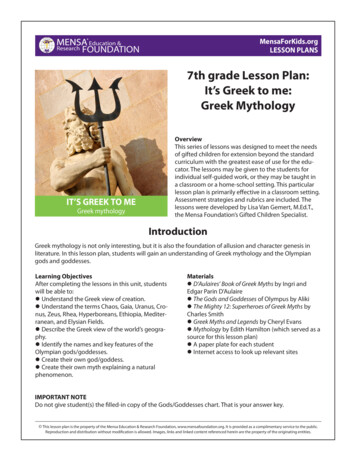
Transcription
Bible GreekBasic Grammarof theGreekNew TestamentJohn PappasA companion book for the Bible Greek Vpod Internet Video Instruction Programbiblegreekvpod.com
CopyrightbyJohn Peter Pappas, Th.M, Th.D2008, 2016ii
Table of ContentsTHE METHOD . 1THE STORY OF LANGUAGE . 2THE STORY OF GREEK . 2THE GREEK OF PALESTINE . 3THE GREEK NEW TESTAMENT MANUSCRIPTS AND MODERN TOOLS. 4THE GREEK ALPHABET . 6THE VOWELS . 7THE DIPHTHONG. 7SYLLABLES . 7PRONUNCIATION. 8BREATHING MARKS . 8ACCENT MARKS . 8PUNCTUATION MARKS . 8A FINAL WORD. 9PRACTICE . 9PRESENT ACTIVE INDICATIVE VERBS.10VOCABULARY .10THE GREEK VERB.10PRESENT ACTIVE INDICATIVE .11PARSING VERBS .12THE PRESENT ACTIVE INDICATIVE .12THE PRESENT ACTIVE INFINITIVE.12PRACTICE .12SECOND DECLENSION NOUNS .14VOCABULARY .14THE GREEK NOUN .14THE SECOND DECLENSION NOUN.15SECOND DECLENSION ENDINGS - MASCULINE .15SECOND DECLENSION ENDINGS - NEUTER .15THE ARTICLE .15SECOND DECLENSION ARTICLE - MASCULINE .16SECOND DECLENSION ARTICLE - NEUTER .16THE ADJECTIVE .17PRACTICE .17FIRST DECLENSION NOUNS .18VOCABULARY .18FIRST DECLENSION NOUNS .18FIRST DECLENSION ARTICLE .18FEMININE FORMS .18MASCULINE FORMS .20PRACTICE .20PRESENT PASSIVE AND MIDDLE INDICATIVE VERBS .22VOCABULARY .22THE PRESENT PASSIVE INDICATIVE .22THE PRESENT MIDDLE INDICATIVE .22i
PRESENT PASSIVE AND MIDDLE INDICATIVE FORM.23PRACTICE .25PREPOSITIONS .27VOCABULARY .27PURPOSE OF THE PREPOSITION .27PREPOSITIONS IN COMPOUND WORDS .28ELISION IN PREPOSITIONS .28PRACTICE .28PERSONAL PRONOUNS .29VOCABULARY .29PERSONAL PRONOUNS .30USAGE .30PRESENT INDICATIVE OF ΕΙΜΊ .31PRESENT INFINITIVE OF ΕΙΜΊ .31PRACTICE .31PRONOUNS.33VOCABULARY .33DEMONSTRATIVE PRONOUNS .33RELATIVE PRONOUNS .34INTERROGATIVE PRONOUNS .34REFLEXIVE PRONOUNS .35PRACTICE .35FIRST AORIST VERBS .37VOCABULARY .37THE AORIST TENSE .37FIRST AORIST ACTIVE INDICATIVE FORM .38FIRST AORIST MIDDLE INDICATIVE FORM .38PRACTICE .39THIRD DECLENSION NOUNS .41VOCABULARY .41THIRD DECLENSION NOUNS .41PRACTICE .44SECOND AORIST VERBS .45VOCABULARY .45SECOND AORIST ACTIVE INDICATIVE .46SECOND AORIST MIDDLE INDICATIVE .46PRACTICE .47FUTURE VERBS .49VOCABULARY .49THE FUTURE TENSE.49FUTURE ACTIVE INDICATIVE FORM.50FUTURE MIDDLE INDICATIVE FORM .51FUTURE INDICATIVE OF ΕΙΜΙ .51PRACTICE .52AORIST AND FUTURE PASSIVE VERBS .53VOCABULARY .53FIRST AORIST PASSIVE INDICATIVE .53ii
SECOND AORIST PASSIVE INDICATIVE.54FUTURE PASSIVE INDICATIVE .55PRACTICE .55IMPERFECT VERBS .57VOCABULARY .57THE IMPERFECT TENSE .57IMPERFECT ACTIVE INDICATIVE FORM .58IMPERFECT MIDDLE INDICATIVE FORM .58IMPERFECT PASSIVE INDICATIVE FORM.59IMPERFECT INDICATIVE OF ΕΙΜΙ .59PRACTICE .59PERFECT AND PLUPERFECT VERBS .61VOCABULARY .61THE PERFECT TENSE .61PERFECT ACTIVE INDICATIVE FORM .62PERFECT MIDDLE AND PASSIVE INDICATIVE FORM .63THE PLUPERFECT TENSE .63PLUPERFECT ACTIVE INDICATIVE.64PRACTICE .64SUBJUNCTIVE AND OPTATIVE MOOD .65VOCABULARY .65THE SUBJUNCTIVE .65THE OPTATIVE.66USES OF THE SUBJUNCTIVE .66THE PRESENT ACTIVE SUBJUNCTIVE .68PRESENT MIDDLE AND PASSIVE SUBJUNCTIVE FORM .69FIRST AORIST ACTIVE SUBJUNCTIVE FORMS.69SECOND AORIST ACTIVE SUBJUNCTIVE FORMS .69PRESENT SUBJUNCTIVE OF ΕΙΜΙ .70PRACTICE .70IMPERATIVE MOOD .71VOCABULARY .71THE IMPERATIVE .71PRACTICE .73PRESENT PARTICIPLES .75VOCABULARY .75THE PARTICIPLE .75VERBAL PROPERTIES .76ADJECTIVAL PROPERTIES .76TRANSLATING THE PARTICIPLE .76THE PRESENT PARTICIPLE .77PRESENT ACTIVE PARTICIPLE .77PRESENT MIDDLE AND PASSIVE PARTICIPLE .78PRACTICE .78AORIST PARTICIPLES .79VOCABULARY .79THE AORIST PARTICIPLE .79FIRST AORIST ACTIVE PARTICIPLE .80FIRST AORIST MIDDLE PARTICIPLE .81FIRST AORIST PASSIVE PARTICIPLE .81iii
SECOND AORIST ACTIVE PARTICIPLE .82SECOND AORIST MIDDLE PARTICIPLE .82PRACTICE .83PERFECT AND FUTURE PARTICIPLES .84VOCABULARY .84THE PERFECT PARTICIPLE .84PERFECT ACTIVE PARTICIPLE .85PERFECT MIDDLE AND PASSIVE PARTICIPLE .85THE FUTURE PARTICIPLE .86FUTURE ACTIVE PARTICIPLE .86FUTURE MIDDLE PARTICIPLE .87FUTURE PASSIVE PARTICIPLE .87PRACTICE .88NUMBERS .89NUMBERS .89CARDINAL NUMBERS .89ORDINALS .90ANSWERS TO PROBLEMS .91VOCABULARY .117iv
PrefaceThe Greek language of the New Testament is such a precise language that onceknown, the reader will no longer be handicapped in the Word. It is not possible tointerpret completely the thoughts of the original author without going to the originalauthor’s language. That means going back to the Hebrew and Greek. Having just acursory knowledge of the original language helps greatly in the understanding of theScriptures, but falls short, especially for the English speaker, in understanding the effectand extent of a particular verse.Luther wrote an important letter, “To the Councilmen of all cities in Germany thatthey establish and maintain Christian Schools.” In this 1524 treatise, Luther wrote:Here belongs also what St. Paul calls for in 1 Corinthians 14, namely, thatin the Christian church all teachers must be judged. For this knowledge ofthe languages is needful above all else. The preacher or teacher canexpound the Bible from beginning to end as he pleases, accurately orinaccurately, if there is no one there to judge whether he is doing it right orwrong. But in order to judge, one must have knowledge of the languages;it cannot be done in any other way. Therefore, although faith and thegospel may indeed be proclaimed by simple preachers without aknowledge of languages, such preaching is flat and tame, people finallybecome weary and bored with it, and it falls to the ground. But where thepreacher is versed in the languages, there is freshness and vigor in hispreaching, Scripture is treated in its entirety, and faith finds itselfconstantly renewed by a continual variety of words and illustrations.Hence, Psalm 129 likens such scriptural studies to a hunt, saying to thedeer God opens the dense forests; and Psalm 1 likens them to a tree with aplentiful supply of water, whose leaves are always green.1It is hoped that this grammar will in some way help the reader come to a betterunderstanding of the Greek New Testament. And that by using the tools of this grammar,the user will be drawn closer to the Lord.cariv umin kai eirhnh(Grace and peace to you)John PappasSeptember 20081Martin Luther, ed. W Brandt and H Lehman, Luther’s Works (Philadelphia: Muhlenberg Press, 1962),pp.357-366v
The MethodThe method used for learning the Greek of the New Testament is based on the internetvideo Bible Greek VPOD produced by the author and what the author received during hisseminary work under the direction of Dr. Mal Couch. Dr. Couch’s method was to “keep itsimple.” This is essential for any first year language course, not just Biblical Greek. Onemust become familiar with the essentials, the fundamentals, without too much time spenton unfamiliar grammar terms. It is by no means implied that the grammar terms are notimportant, nor is it the point of this program to omit technical words, but the mechanicsof the language must be introduced without over-whelming the student. The basics mustbe introduced and understood then the technical details can be presented so the studentcan grow.This program is based on the three fundamentals: Chapter reading of the grammar book Video instruction using the Biblegreekvpod lessons Then, back to the book and practice exercisesThis method is simple, straight to the point, and proven. It is the purpose of thismethod and program that the student will gain a quick confidence working with thelanguage and the love and value for it will grow.Working the practice exercises is extremely valuable. There is no substitute formemorizing the vocabulary and translating the verses. The volume of words to memorizefor each lesson is manageable, and the translation work limited to five or six verses. Theselection is made in order for the student to become experienced in the subject of thechapter yet blessed since many of the verses have been chosen so that the student will beexcited about the “meat” of the Scriptures. The verses were selected for the most partbecause of their doctrinal meat not just verses for practice sake. Use a Bible, in factseveral versions of the Bible when translating so as to get acquainted with variations. Donot get hung up on the variations – just do the basic translations work and wait untilintermediate Greek to understand the variations.May your time be spent in the word, not around the word. May the riches anddepths of His word bless you greatly.
Chapter OneThe Story of LanguageThe Greek of the New Testament is very unique. It is, in a word – preserved. Preservedfor all time. Frozen in time by a sovereign God who has preserved His Word in the Hebrew ofthe Old Testament and Greek of the New in order for all mankind to have a precise knowledge ofwhat He has to say. In fact, God created Adam mature for fellowship with Him. Therefore,Adam was either created already knowing a language or shortly after his creation was “gifted”(supernaturally given) with a complex language to talk with the pre-incarnate Christ in thegarden. Adam, Eve and God walked and talked in the garden.It did not take long for man to disobey God’s Word and mankind fell. Through one man’ssin, death entered the world. Adam and Eve and all their descendents did, however, obey God’scommand to populate the earth and soon the number of people on the earth increased greatly andsin multiplied. Evilness increased so much that God had to miraculously confuse the commonlanguage. Different language groups were born and mankind separated, by families, into uniqueethnic groups.Language is predominantly a spoken form of communication, but God preserves HisWord in the written form. The spoken form is more versatile in that one can stress certain wordsby the inflection of the voice. In the written form, God gave man a way to preserve His Word ina permanent record, and commands mankind to preserve His sacred word faithfully andcarefully.Legal documents, trade records, history, ancient and modern, are all recorded in writing.All languages have certain fundamental elements with rules that regulate its form. This has to beor communication with each other would be impossible. All those years in school taking Englishfor the purpose of teaching us how to read and write are for the purpose of teaching propercommunication with all its rules. In America, the early Puritans wanted all children to learn howto read and write so
The Greek of the New Testament is very unique. It is, in a word – preserved. Preserved for all time. Frozen in time by a sovereign God who has preserved His Word in the Hebrew of the Old Testament and Greek of the New in order for all mankind to have a precise knowledge of what He has to










